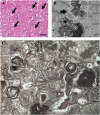Hypertrophic cardiomyopathy in a lupus patient: a case of hydroxychloroquine cardiotoxicity
- PMID: 31493341
- PMCID: PMC6989295
- DOI: 10.1002/ehf2.12508
Hypertrophic cardiomyopathy in a lupus patient: a case of hydroxychloroquine cardiotoxicity
Abstract
Hydroxychloroquine (HCQ) is a well-established and effective immunomodulatory therapy for systemic lupus erythematosus and other autoimmune diseases. While retinal toxicity is a well-recognized complication, cardiotoxicity is lesser known. This case consists of a 63-year-old Filipina on chronic HCQ treatment that led to severe biventricular hypertrophy, increased filling pressure, systemic and pulmonary hypertension, and elevated brain natriuretic peptide. Genetic testing ruled out lysosomal storage disorders but revealed five rare variants of uncertain significance, including one that was temporarily re-classified as likely pathogenic. Endomyocardial biopsy demonstrated myeloid bodies admixed with curvilinear bodies, most consistent with a diagnosis of HCQ toxicity. This case illustrates the importance of clinical integration of multiple causes of cardiomyopathy, recognition of HCQ cardiotoxicity, and increased uncertainty in genetic test findings among racial minorities.
Keywords: Hydroxychloroquine; Hypertrophic cardiomyopathy; Minority; Myeloid bodies; Variant of uncertain significance.
Conflict of interest statement
None declared.
Figures



Similar articles
-
Hydroxychloroquine in lupus: emerging evidence supporting multiple beneficial effects.Intern Med J. 2012 Sep;42(9):968-78. doi: 10.1111/j.1445-5994.2012.02886.x. Intern Med J. 2012. PMID: 22827853 Review.
-
Restrictive Cardiomyopathy Associated With Long-Term Use of Hydroxychloroquine for Systemic Lupus Erythematosus.J Pharm Pract. 2017 Oct;30(5):571-575. doi: 10.1177/0897190016655726. Epub 2016 Jun 26. J Pharm Pract. 2017. PMID: 27353145 Review.
-
[Toxic hydroxychloroquine-induced cardiomyopathy complicating systemic lupus treatment].Ann Pathol. 2021 Feb;41(1):101-104. doi: 10.1016/j.annpat.2020.09.007. Epub 2021 Jan 6. Ann Pathol. 2021. PMID: 33419598 French.
-
Hydroxychloroquine-induced cardiotoxicity in a 39-year-old woman with systemic lupus erythematosus and systolic dysfunction.J Am Soc Echocardiogr. 2005 Sep;18(9):981. doi: 10.1016/j.echo.2005.01.012. J Am Soc Echocardiogr. 2005. PMID: 16153529
-
Maculopathy in patient with systemic lupus erythematosus treated with hydroxychloroquine.Reumatol Clin. 2012 Sep-Oct;8(5):280-3. doi: 10.1016/j.reuma.2011.12.012. Epub 2012 Apr 4. Reumatol Clin. 2012. PMID: 22481059
Cited by
-
Cardiac Complications Attributed to Hydroxychloroquine: A Systematic Review of the Literature Pre-COVID-19.Curr Cardiol Rev. 2021;17(3):319-327. doi: 10.2174/1573403X16666201014144022. Curr Cardiol Rev. 2021. PMID: 33059567 Free PMC article.
-
Severe Hypertrophic Cardiomyopathy Associated With Hydroxychloroquine in a Young Woman With Systemic Lupus Erythematosus: A Case Report and Review of the Literature.Cureus. 2024 May 31;16(5):e61452. doi: 10.7759/cureus.61452. eCollection 2024 May. Cureus. 2024. PMID: 38947707 Free PMC article.
References
-
- Marmor MF, Kellner U, Lai TY, Melles RB, Mieler WF. American Academy of O. Recommendations on screening for chloroquine and hydroxychloroquine retinopathy (2016 Revision). Ophthalmology 2016; 123: 1386–1394. - PubMed
-
- Costedoat‐Chalumeau N, Hulot JS, Amoura Z, Delcourt A, Maisonobe T, Dorent R, Bonnet N, Sablé R, Lechat P, Wechsler B, Piette JC. Cardiomyopathy related to antimalarial therapy with illustrative case report. Cardiology 2007; 107: 73–80. - PubMed
-
- Authors/Task Force members , Elliott PM, Anastasakis A, Borger MA, Borggrefe M, Cecchi F, Charron P, Hagege AA, Lafont A, Limongelli G, Mahrholdt H, McKenna WJ, Mogensen J, Nihoyannopoulos P, Nistri S, Pieper PG, Pieske B, Rapezzi C, Rutten FH, Tillmanns C, Watkins H. 2014 ESC Guidelines on diagnosis and management of hypertrophic cardiomyopathy: the task force for the diagnosis and management of hypertrophic cardiomyopathy of the European Society of Cardiology (ESC). Eur Heart J 2014; 35: 2733–2779. - PubMed
-
- Melles RB, Marmor MF. The risk of toxic retinopathy in patients on long‐term hydroxychloroquine therapy. JAMA Ophthalmol 2014; 132: 1453–1460. - PubMed
Publication types
MeSH terms
Substances
Grants and funding
LinkOut - more resources
Full Text Sources

